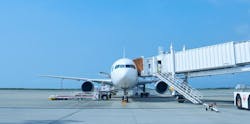Panasonic teams with manufacturer to develop automated passenger bridge using AI and deep learning
Continue reading original article
The Intelligent Aerospace take:
March 15, 2019-Japan is in an unenviable situation as it has to prepare for a fairly large population loss over the next four decades. The Japanese government estimates that the population will shrink to 88 million from the current 127 million in that time frame. The median age in Japan is nearly 49, and most Japanese companies require workers to retire at age 60. Currently, there are approximately 4 people born for every 5 that die, so the country has a negative replacement rate.
Next year, Tokyo will host the Summer Olympics, and aims to maintain its reputation for punctuality in transportation. One of the ways it may do so is with Panasonic's automated passenger boarding bridge (PBB) that brings the bridge to within 10 centimeters of the airplane door, removing the need for experienced workers doing a difficult task.
"Differences in PBB operation naturally occur between veteran operators and technicians with little experience," says Yasuhiro Tsuyuguchi, Executive Director, Tokushima Air Terminal Building Co., Ltd. "The ability to maintain on-time performance without delays and prevent human errors with a highly reliable function is an extremely large advantage. In addition to this, the airport ground crews truly have a difficult job. Their work is becoming increasingly complicated, and they require considerable studying to gain certification. The staff also becomes aged, making it difficult to employ people from the continually decreasing labor pool. This is why we look forward to the development of systems that incorporate AI to provide greater assistance to the presently working staff. It's an ideal system that allows elderly staff, women, and others to work longer and remain strong."
Related: Swedish group says UAS solutions will help automate daily operations in airports
Related: Five advances that will define the aerospace and defense industry in 2019
Jamie Whitney, Associate Editor
Intelligent Aerospace
Ready to make a purchase? Search the Intelligent Aerospace Buyer's Guide for companies, new products, press releases, and videos
